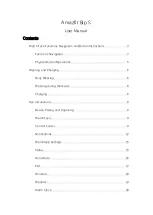
PILOT’S WATCH CHRONOGRAPH SPITFIRE
PILOT’S WATCH CHRONOGRAPH SPITFIRE
— 3 2 —
— 3 3 —
REMOVING INDIVIDUAL LINKS AND ATTACHING THE BRACELET
Repeat steps 1 to 3 at the distance from the first point of separ ation you have just determined.
Remove the unnecessary links and reassemble the shortened bracelet. When reassembling the central
link, make sure that the outside is still facing downwards.
Reinsert the external link with the two hinged links, which was removed at the beginning, back into
the bracelet (4). Now you can slide the opposing external bracelet link back into the bracelet until it
lies flush, by simultaneously pressing down its fixing bolt (5).
To finish, check that the fixing bolts are sitting correctly (6). These must be brought up flush with the
upper edge of the external links.
Keep the surplus links and separating tool in a safe place for use in any adjustments at another time.
INFORMATION ABOUT MAGNETIC FIELDS
As a result of the ever greater prevalence in recent years of very strong magnets made from rare-earth
alloys (e.g. neodymium-iron-boron) – these are found in objects such as loudspeakers and mobile
phones and fasteners on jewellery as well as handbags – mechanical watches are increasingly likely to
come into contact with such magnets and become magnetized. This can lead to the watch rate being
permanently affected, a problem that can only be resolved by a process of demagnetization carried
out by a specialist. We recommend that you keep your watch away from such magnets.
Watches with a soft-iron inner case provide a higher level of protection against magnetic fields and far
exceed the requirements of DIN standard 8309. Nevertheless, it is still possible for the watch move-
ment to become magnetized in close proximity to very strong magnets. We therefore recommend
that watches with a soft-iron inner case also be kept away from direct contact with strong magnets.
Should there be a sudden change in the precision of your timepiece, please contact an authorized
IWC Official Agent to have your watch checked for magnetism.
WATER-RESISTANCE
The water-resistance of IWC watches is stated in bar and not in metres. Metres, which are often used
elsewhere in the watch industry to indicate water-resistance, cannot be equated with dive depth
because of the test procedures that are frequently used. Water-resistance shown in metres provides
no indication as to actual use of the watch in the presence of moisture and wetness, and in or under
water. Recommendations for use in connection with the water-resistance of your watch can be found
Summary of Contents for PILOT'S WATCH CHRONOGRAPH SPITFIRE
Page 54: ......
Page 55: ...WWW IWC COM ...
















































